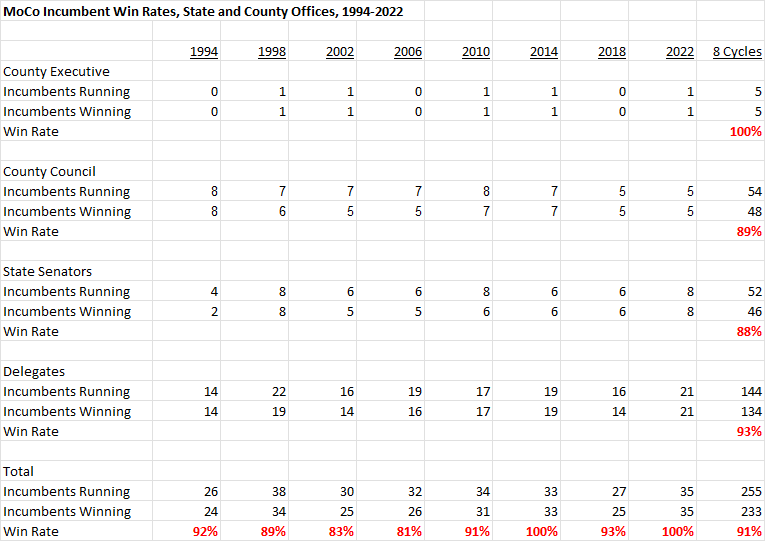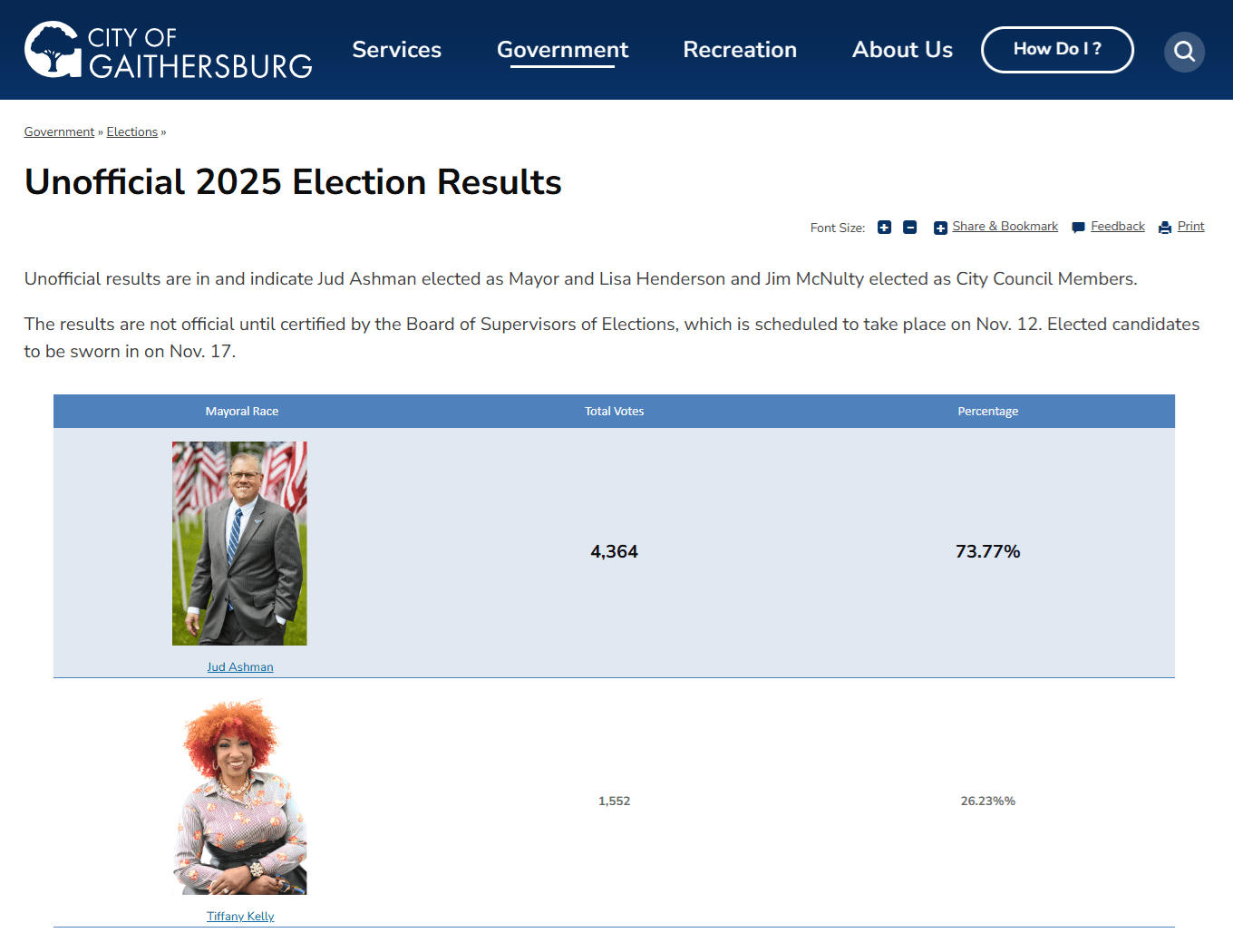By Adam Pagnucco.
Back in March 2021, I wrote a column titled It’s Hard to Beat Incumbents. That’s one of the most basic premises of politics, but sometimes it gets buried by hard-charging challengers, social media hyperbole and the passions of the day. And in Montgomery County, the difficulty of defeating incumbents is as clear as everywhere else. We just saw it again last Tuesday night.
First, let’s go to the data. (That’s our specialty on Montgomery Perspective!) The chart below shows MoCo incumbent reelection win rates for the offices of county executive, county council, state senator and delegate over the last eight cycles (1994 through 2002). I am not including the current legislative districts mostly located in Howard County or school board incumbents, who usually have little if any money or name recognition. During that period, when incumbents ran for the same offices they held, they had a combined win rate of 91%. In two of the last three cycles, they had a 100% win rate.

Additionally, consider that only one county executive in the county’s history was ever defeated when running for reelection (Sidney Kramer, who lost in 1990 to Council Member Neal Potter). And the last time a Democratic district council incumbent lost was in 1998 (District 3’s Bill Hanna, who lost to Phil Andrews).
Incumbents can accumulate enormous advantages in name recognition, media coverage, fundraising and the opportunities to perform constituent service, form relationships and build records in office. Now add in the decline of local media and it’s hard for challengers to get oxygen. Even good ones struggle to climb the mountain.
In a five-part series in 2010, I looked at the major reasons why MoCo incumbents lost. I identified four: they are Republicans, they get lazy and take their races for granted, they make too many enemies in their districts and – the rarest reason of all – they draw historically great challengers. That last reason is rather subjective, but consider the challengers I picked as illustrations: Chris Van Hollen (1994), Andrews (1998), Rob Garagiola (2002) and Jamie Raskin (2006). Ask yourself if a challenger you favor is comparable to CVH or Jamie before deciding whether they’re truly great enough to knock out an incumbent.
Now to Tuesday. Long-time Gaithersburg Mayor Jud Ashman defeated challenger Tiffany Kelly on a 74-26% vote at this writing. Lots of folks are saying all kinds of things about this, like voters are allegedly centrist; progressives are not as popular as believed; rent control (which Ashman opposes) is supposedly unpopular; and somehow this means that Andrew Friedson will win the county executive race. The one thing that unites all of these theories is that they are accompanied by little or any data to back them up.

The unofficial results of the 2025 Gaithersburg mayor’s race.
Well, look at the data we posted above and the most obvious explanation is that Ashman is a strong incumbent who ran against a first-time city candidate. Ashman has been in city office since 2007 and has been mayor since 2014. He is the creator of the Gaithersburg Book Festival, which has become the city’s premier cultural event. He is an amiable fellow, shows up all over his city, lacks prominent enemies and has no obvious holes in his record. The city is one of the best-governed municipalities in the state owing to its professional staff and its political culture of civility, which wards off drama and long predates Ashman’s tenure. On top of all that, when Kelly’s challenge emerged, Ashman saw it coming and went all-out to the doors. In military terms, he was a hardened target for any insurgency.
Meanwhile, Kelly was a quality challenger. She was active on social media, ran to Ashman’s left (not a bad idea in MoCo politics), was a good fundraiser and was backed by aggressive door-knocking from members of the Democratic Socialists and CASA. She may not have been competitive against a hard-working incumbent like Ashman, but put her in an open seat race and she would definitely have a shot to win.
A big problem in extrapolating anything from a municipal race to a county Democratic primary is the profound structural differences between the two. Municipal races allow members of all parties to vote whereas Maryland Democratic primaries are closed to Democrats. Turnout rates are different. The recent Gaithersburg election had 14% turnout while the 2022 MoCo Dem primary had 36% turnout. Many more groups, including unions, developers and possibly the Washington Post, play in Dem primaries than in municipal elections. Candidates in Dem primaries have waaaaaay more money than in municipal elections. And since MoCo municipalities are small compared to the county as a whole, their politics are not necessarily representative of the county. Gaithersburg voters, for example, have a record of preferring more centrist types than the Downcounty folks who typically exert sway over MoCo elections. Accordingly, comparing a municipal election to a MoCo Dem primary is like comparing a pea shooter to a Tommy gun.
Finally, there is another huge difference between the Gaithersburg mayor’s race and the coming MoCo executive primary: the latter is a contest for an open seat. Friedson and his two strongest opponents – Council Members Evan Glass and Will Jawando – all have strengths, but none of them have incumbent strength. And control of the county council will depend on the results of five open seat races with little real threat expected to materialize against the incumbents. (A possible exception is at-large Council Member Laurie-Anne Sayles, who will have to work hard to retain her seat with quality non-incumbents in her race.)
So let’s not get carried away. Events in Gaithersburg will not necessarily predict whatever happens in coming county elections. And while MoCo incumbents aren’t invincible, you better have an excellent game plan, lots of money, tons of outside support, a lazy and/or incompetent opponent and a whole bunch of luck to beat one of them.
